
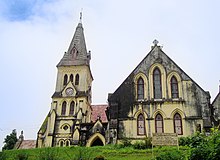

The culture of Darjeeling , India, is diverse and has a regional distinctness. [1]



The culture of Darjeeling , India, is diverse and has a regional distinctness. [1]
The two predominant religions of Darjeeling are Hinduism and Vajrayana Buddhism. Dashain, Tihar, Buddha Jayanti, Christmas, Holi, Ram Navami, etc. are the main festivals. Besides them, the diverse ethnic populace of the town also celebrates several local festivals. Buddhist ethnic groups such as the Lepchas, Bhutias, Sherpas, Yolmos, Gurungs, and Tamangs celebrate new year called Losar in January/February through festivals called Maghe Sankranti, Chotrul Duchen, and Tendong Lho Rumfaat. The Kirati ethnic groups such as Limbu (Subba), Yakkha, Sunuwar, Rai (Khambu) celebrate their festivals of Ubhauli Udhauli, Sakela and Chasok Tangnam etc. Deusi/Bhailo are songs performed by men and women, respectively, during the festival of Tihar.
Darjeeling Carnival, initiated by a civil society movement known as The Darjeeling Initiative, was a ten-day carnival held yearly during winter that portrayed the rich musical and cultural heritage of Darjeeling Hills as its central theme. [2] Every year, cultural festivals are held in the town of Darjeeling and its surrounding areas.
The people of Darjeeling consume a diverse variety of foods. Each ethnic group has its own distinct traditional food. A popular food in Darjeeling is the momo , a steamed dumpling containing chicken, mutton, pork, beef or vegetables cooked in a doughy wrapping served with a watery vegetable soup and spicy tomato sauce/chutney. Indigenous fermented food products such as gundruk (fermented and dried leafy vegetable), kinema (fermented soybean), and sinki (fermented and dried radish) are consumed by the people. Wai-Wai is a favorite packaged snack of Darjeeling hills comprising noodles that are eaten either dry or with soup. Hard chhurpi, a type of hard cheese made from cow or yak's milk, is another popular mini-snack that is both nutritious and masticatory. Soft chhurpi, a traditional soft cheese, is consumed along with green vegetables as savoury dishes, used as filling for momos, ground with tomatoes and chillies for chutney or made into a refreshing soup. A type of noodle called thukpa, served with soup and vegetables/meat, is extremely popular in and around the hills of Darjeeling. There are a number of restaurants offering a variety of traditional Indian, Continental and Indian Chinese cuisine to cater to tourists. Tea is the most popular beverage, procured from the famed Darjeeling tea gardens, as well as coffee. Chhang or jaanr is a local alcoholic beverage made from fermented millet, maize or rice.

Colonial architecture characterizes many buildings in Darjeeling; several cottages, Gothic churches, the Raj Bhawan (Governor House), Planters' Club and various educational institutions are examples. [3] [4] Buddhist monasteries showcase the pagoda-style architecture.
Darjeeling is regarded as a center of music and a hotbed for musicians and music admirers. Singing and playing musical instruments is a common pastime among the resident population, who take pride in the traditions and role of music in their cultural life. [5] The varied ethnic groups have different types of songs and dances, often associated with festivals. Some dances of Nepali origin include Maruni, Dhan dance, Jhankri, Yatra, Damphu (Tamang selo), Balan, Deora, Khukuri, Pancha Buddha, Dhimay, Sangini, Chutki, Jhyaure, Sakhiya. [6] Western music is popular among the younger generation, and Darjeeling is a major center of Nepali rock music. Prashant Tamang, the winner of Indian Idol 3, is a resident of Darjeeling.
Football is the most popular sport in Darjeeling. An improvised form of ball made of rubber bands is often used for playing in steep streets, and is known as Chungi. [7] [8]
Darjeeling is also a popular setting for Bollywood and Bengali films. Noted Bengali film director Satyajit Ray shot his film Kanchenjungha (1962) here. Bollywood movies such as Aradhana (1969), Raju Ban Gaya Gentleman (1992), Main Hoon Na (2004), Parineeta (2005), Barfi! (2012), Yaariyan (2014) and Jagga Jasoos (2017) were partially filmed in town. [9] [10]
Some notable places to visit include the Tiger Hill (a panoramic view of Mount Everest and Mount Kanchenjunga together), the Padmaja Naidu Himalayan Zoological Park (notable for conservation of red pandas), monasteries, and the tea gardens. The town attracts trekkers and sportsmen seeking to explore the Himalayas, serving as the starting point for climbing attempts on some Indian and Nepali peaks. Tenzing Norgay, one of the two men to first climb Mount Everest, spent most of his adult life in the Sherpa community in Darjeeling. His success provided the impetus to establish the Himalayan Mountaineering Institute in Darjeeling in 1954. In the Tibetan Refugee Self Help Centre, Tibetan crafts like carpets, wood, and leather work are displayed. Colonial architecture is exemplified in Darjeeling by cottages, St. Andrew's Church, Darjeeling Gothic churches, [11] Planters' Club, [12] the Raj Bhawan and various educational institutions. [3] [4] Several monasteries like Ghoom Monastery (8 km or 5 miles from the town), Bhutia Busty monastery, Mag-Dhog Yolmowa preserve ancient Buddhist scripts. A Peace Pagoda was built in 1992 by the Japanese Buddhist organisation Nipponzan Myohoji. [13] The Mahakal Temple on Observatory Hill is a pilgrimage site for Hindu and Buddhists. [14] Although tourists have come to Darjeeling in vastly greater numbers after India's economic liberalisation, they have spent less on average, resulting in Darjeeling's luxury tourism increasingly giving way to mass tourism. [15] Since 2012, Darjeeling has once again witnessed a steady inflow of both domestic and international tourists. As of 2015, around 50,000 foreign and 500,000 domestic tourists visit Darjeeling each year, [16] the so-called "Queen of the Hills" continuing to appeal strongly to the imagination of tourists. [17]

Darjeeling is a city in the northernmost region of the Indian state of West Bengal. Located in the Eastern Himalayas, it has an average elevation of 2,045 metres (6,709 ft). To the west of Darjeeling lies the easternmost province of Nepal, to the east the Kingdom of Bhutan, to the north the Indian state of Sikkim, and farther north the Tibet Autonomous Region region of China. Bangladesh lies to the south and southeast, and most of the state of West Bengal lies to the south and southwest, connected to the Darjeeling region by a narrow tract. Kangchenjunga, the world's third-highest mountain, rises to the north and is prominently visible on clear days.

Kalimpong is a town and the headquarters of an eponymous district in the Indian state of West Bengal. It is located at an average elevation of 1,250 metres (4,101 ft). The town is the headquarters of the Kalimpong district. The region comes under Gorkhaland Territorial Administration which is an autonomous governing body within the state of West Bengal. The Indian Army's 27 Mountain Division is located on the outskirts of the city.

Gorkha National Liberation Front (GNLF) is a political party in the Darjeeling District of West Bengal, India. It was formed in 1980 by Subhash Ghisingh with the objective of demanding a Gorkhaland state within India.
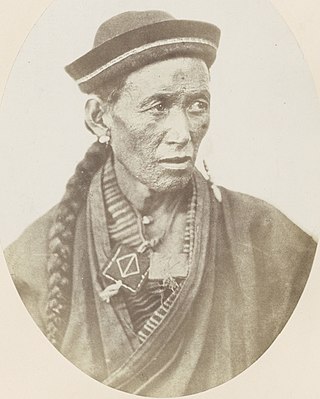
The Bhutias or Drejongpas are a Tibetan ethnic group native to the Indian state of Sikkim who speak Drejongke, a Tibetic language which descends from old Tibetan. In addition to the majority of them living in the state of Sikkim, significant numbers of them also reside in the Darjeeling and Kalimpong districts of northern West Bengal as well as in countries such as Nepal and Bhutan.

Darjeeling District is the northernmost district of the state of West Bengal in eastern India in the foothills of the Himalayas. The district is famous for its hill station and Darjeeling tea. Darjeeling is the district headquarters. Kurseong, Siliguri and Mirik, three major towns in the district, are the subdivisional headquarters of the district. Kalimpong was one of the subdivisions but on 14 February 2017, it officially became a separate Kalimpong district.
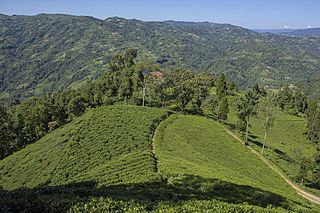
Ilam district is one of 14 districts of Koshi Province of eastern Nepal. It is a Hill district and covers 1,703 km2 (658 sq mi). The 2011 census counted 290,254 inhabitants. The municipality of Ilam is the district headquarters and is about 600 km (370 mi) from Kathmandu.
Darjeeling district's population today is constituted largely of the descendants of the indigenous and immigrant labourers that were employed in the original development of the town. Although their common language, the Nepali language, has been given official recognition at the state and federal levels in India, the recognition has brought little economic progress to the region, nor significant political autonomy. A culture of both pride and dependence has evolved in the tea plantations where jobs have levelled off but housing can be inherited by a worker within the family. The population of Darjeeling meanwhile has grown substantially over the years. Many young locals, educated in government schools, have taken to migrating out for the lack of employment matching their skills. Like out-migrants from other regions of northeastern India, they have been subjected to discrimination and racism in some Indian cities.

Darjeeling Carnival is a ten-day carnival arranged in the town of Darjeeling, West Bengal, India.

Observatory Hill is a hill near Chowrasta square, or The Mall as it is popularly known, in Darjeeling, West Bengal, India. Views of snow-clad peaks, including Mount Kanchenjunga, are visible from the Observatory Hill. The Bhutia Busty monastery was originally located here. Now the hill has the temple of Mahakal. Two important arteries of the town, Nehru Road and Bhanubhakta Sarani, meet at Chowrasta. Another school of thought suggests that the presence of the megalithic core to have been a place of worship of the Rongs, representing a sacred location of the classic Long Chok type.

Happy Valley Tea Estate is a tea garden in Darjeeling district in the Indian state of West Bengal. Established in 1854, it is Darjeeling's second oldest tea estate. Spread over 177 hectares, it is situated at a height of 2,100 metres (6,900 ft) above sea level, 3 kilometres (1.9 mi) north of Darjeeling, and employs more than 1500 people.
In the cuisine of Sikkim, in northeastern India, rice is a staple food, and fermented foods traditionally constitute a significant portion of the cuisine. Nepalese cuisine is popular, as Sikkim is the only state of India with an ethnic Nepali majority. Many restaurants in Sikkim serve various types of Nepalese cuisine, such as the Limbu, Newa and Thakali cuisines. Tibetan cuisine has also influenced Sikkimese cuisine. The combination of various cuisines has resulted in one specific cuisine.

Pakyong is a city and district headquarters of Pakyong district in the Indian state of Sikkim, located in the foothills of the Himalayas. Pakyong Airport is the only airport of Sikkim, which is not operational. The "National Research Centre for Orchids" is also located here.
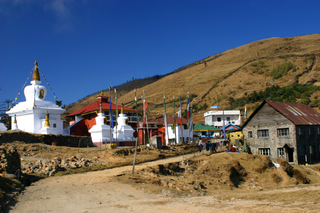
Meghma is a small hamlet inside the Singalila National Park in the Darjeeling subdivision, Darjeeling district in the state of West Bengal in India near the India - Nepal border, and lies on the Sandakphu trek.
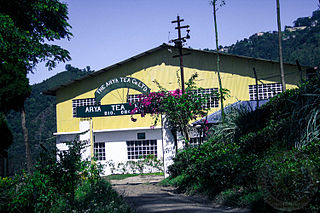
Arya Tea Estate is a tea garden in the Darjeeling Pulbazar CD block in the Darjeeling Sadar subdivision of the Darjeeling district in West Bengal, India

Indian Gorkhas, also known as Nepali Indians, are people of Nepali origin who migrated from Nepal to India. They are an ethno-cultural group who speak Nepali as a common language. They inhabit mainly the states of Sikkim, West Bengal, Northeast India and Uttarakhand, including their diaspora elsewhere in India and abroad. The modern term "Indian Gorkha" is used to differentiate the Nepali language Speaking Indians from Nepalis.

West Bengal is a state in the eastern region of India and is the nation's fourth-most populous state. The state capital is Kolkata. The state encompasses two broad natural regions: the Gangetic Plain in the south and the sub-Himalayan and Himalayan area in the north. The tourism in West Bengal is maintained by WBTDCL, a state government owned enterprise.

Kalimpong district is a district in the state of West Bengal, India. In 2017, it was carved out as a separate district to become the 21st district of West Bengal. The district is headquartered at Kalimpong, which grew to prominence as a market town for Indo-Tibetan trade during the British period. It is bounded by Pakyong district of Sikkim in the north, Bhutan in the east, Darjeeling district in the west, and Jalpaiguri district in the south.

The Mahakal Temple or Mahakal Mandir. Translation: The master of Kaal[time]) is a sacred Hindu temple located in Darjeeling, West Bengal, India, dedicated to the Hindu god Shiva, the third god in the Hindu triumvirate. The temple was built in 1782 by Lama Dorjey Rinzing and is perched atop the Observatory Hill and is an amalgamation of Hindu and Buddhist religions. It is a religious site where both religions coexist harmoniously.

Chowrasta "Intersection" lit. where four roads meet) is a historical public square in the Victorian era hill resort town of Darjeeling in the state of West Bengal, India. Located in the heart of the town it was the fashionable place of assembly for residents and visitors in the 18th century. Chowrasta is situated on the ridge of the Darjeeling hill range and is now a center of tourist attraction and a popular spot for the residents to assemble.